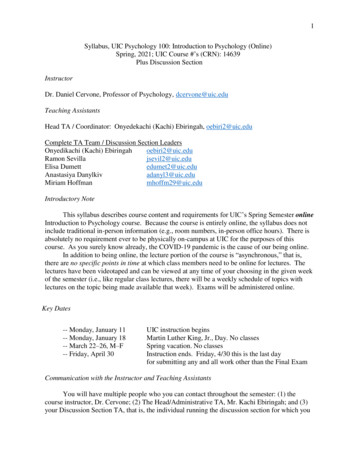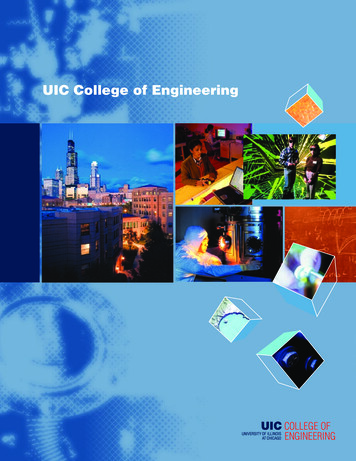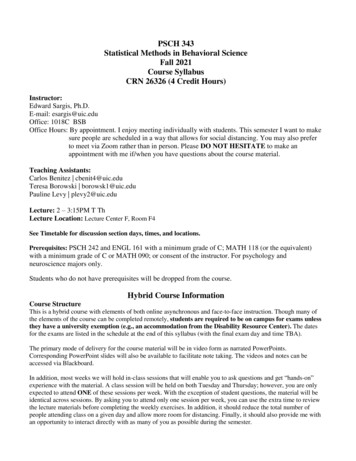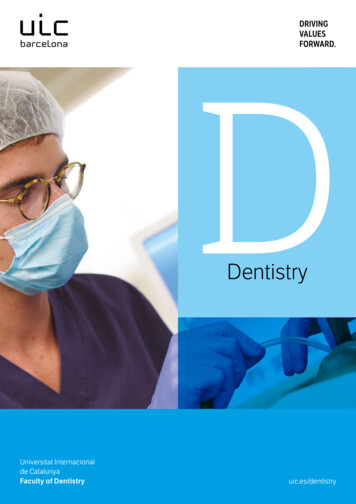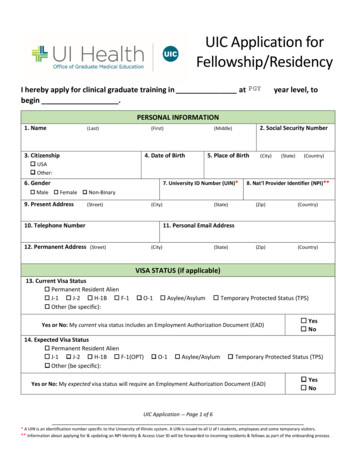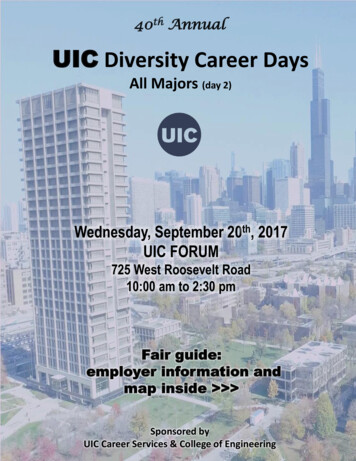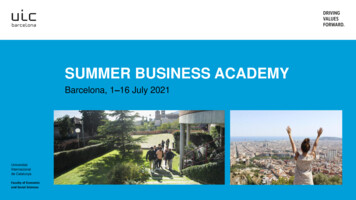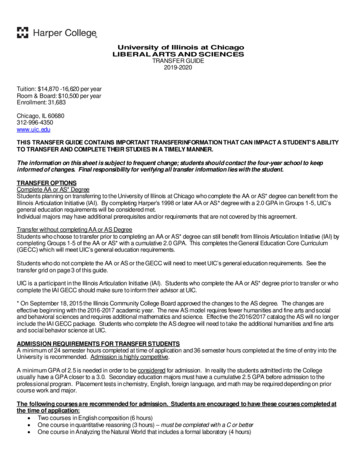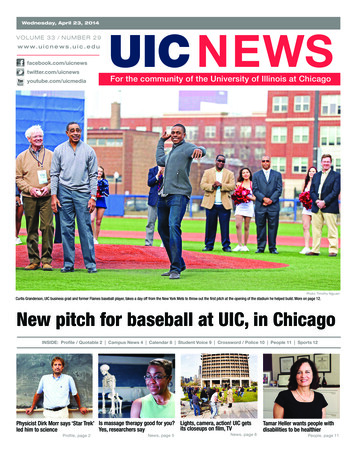
Transcription
Wednesday, April 23, 2014VOLUME 33 / NUMBER 29w w w. u i c n e w s . u i c . e d m/uicmediaUIC NEWSFor the community of the University of Illinois at ChicagoPhoto: Timothy NgyuenCurtis Granderson, UIC business grad and former Flames baseball player, takes a day off from the New York Mets to throw out the first pitch at the opening of the stadium he helped build. More on page 12.New pitch for baseball at UIC, in ChicagoINSIDE: Profile / Quotable 2 Campus News 4 Calendar 8 Student Voice 9 Crossword / Police 10 People 11 Sports 12Physicist Dirk Morr says ‘Star Trek’ Is massage therapy good for you? Lights, camera, action! UIC getsits closeups on film, TVYes, researchers sayled him to scienceProfile, page 2News, page 5News, page 6Tamar Heller wants people withdisabilities to be healthierPeople, page 11
2UIC NEWSprofileI www.uicnews.uic.edu IAPRIL 23, 2014Send profile ideas to Gary Wisby, gwisby@uic.eduPhysicist Dirk Morr finds scientific facts in science fictionBy Gary WisbyScotty emulators can’t beam anybodyup — not yet, anyway — but much of what“Star Trek” showed us 50 years ago as science fiction is scientific fact today, says UICphysics professor Dirk Morr.One example: Lt. Uhura’s earpiece, forerunner of the nowubiquitous Bluetooth device.Nanoprobes, which turned people into borgs on theshow’s “Next Generation,” are used to save lives today, injected to “attach to cancer cells — they’re metallic so they heatup very rapidly and destroy the cells,” Morr said.The alien translator used by Captain Kirk and crew findsits latter-day equivalent in a phone app “where you say a sentence and it’s translated into French or Spanish,” he said.The communicator flip-device? “Our smart phones,” hesaid, “are much more powerful and versatile.”Kirk also made use of a tablet that foresaw the iPad oftoday.What “Star Trek” tech isn’t here yet?Warp drive would require penetrating the wall that is thespeed of light, i.e., moving even faster. Is that possible?“The special theory of relativity tells us no, but will we beable to get through in the future? We really don’t know at themoment,” Morr said.“But the only thing that separates us from that is a brilliantidea.”Wormholes, on the other hand, are already known to bepossible.He demonstrates with a piece of paper. Placing the left andright edges of the paper together, Morr illustrates a wormhole, the bending of space and time for instantaneous travel.“In 1988 at Caltech, Kip Thorne showed that you couldcreate wormholes that would live long enough that you couldmove through them,” he said, although we don’t yet knowhow.No less a challenge is beaming technology, which requiresthe conversion of mass into energy.Scotty used to beam Kirk, Mr. Spock & Co. up to the starship Enterprise every week. But to beam even a sandwich,Morr said, “would require us to store as much energy as theentire world uses in about an hour.”How about a 12,000-pound elephant? “The energy wouldbe equal to that of world consumption in a year, while theamount of information we needed to store would be 100 trillion times the size of the World Wide Web,” he said.Morr talked about all this April 2 at a lecture on campus,sponsored by the Chicago Council on Science and Technol-Photo: Roberta Dupuis-DevlinDirk Morr’s fascination with “Star Trek” while he was growing up started him on his journey into a science career. “It’s a trait of scientists thatwe want to see what’s around the corner. It’s why many of us become scientists,” says Morr, professor of physics.ogy, titled “The Real Science Behind ‘Star Trek.’”Its genesis was an exhibit called “Science Storms” that hehelped create for the Museum of Science and Industry, whichopened in 2010.“They wanted to see if the exhibit could duplicate the research we were doing in our computer and labs,” he said.Similarly, he wanted “to connect something as popular as‘Star Trek’ with the cutting-edge research we’re doing at UICand other universities,” he said.“Star Trek” first aired in 1966 to 1969. It was shown inGermany, where Morr grew up, in the early ’70s when he wasa kid.“I was fascinated by the idea of jumping into a space shipand going to distant galaxies,” he said.He earned a master’s degree at the Free University ofBerlin and a Ph.D. at the University of Wisconsin-Madison,followed by post-doctoral work at Urbana-Champaign. He wasa director’s fellow at Los Alamos National Laboratory in NewMexico for two years before joining UIC in 2001. He is alsoan associate of the James Franck Institute at the University ofChicago.Morr lives in Chicago’s Edgebrook neighborhood with hiswife, Elizabeth Elliott, professor of Slavic linguistics at Northwestern University, and their children, Leni, 8, and son, Max, 6.A fan of literature, he recently re-read War and Peace.How much did his early interest in “Star Trek” have to dowith his trek to academic stardom?“I would say it definitely started a fascination with science,”Morr said.“It’s a trait of scientists that we want to see what’s around thecorner. It’s why many of us become scientists.”gwisby@uic.eduquotable“This is big not only for the university, but what weboth wanted was for it to reach the community inChicago too.”Curtis Granderson, UIC business grad and New YorkMets outfielder, on the opening of UIC’s new CurtisGranderson Stadium, April 17 New York Daily News“Our program can review medical records. We cantalk to doctors. On occasion, I will go out. And whenI do, it’s like having people from CBS News from ‘60Minutes’ come by. It usually means something not sogood.”Michael Naylor, associate professor of psychiatry anddirector of a state-mandated program that reviews psychiatric medications prescribed to children in foster care,April 16 Denver Post“Of course, most people do not understand thereality that probably 98 percent of racism is learnedbehavior, and maybe 2 percent is due to some serious underlying personality problems.”Carl Bell, professor of psychiatry, answers the question“Are Racists Mentally Ill?,” April 16 Chicago Tribune
APRIL 23, 2014IUIC NEWSI www.uicnews.uic.edu3Aviation leader: going green saves moneyBy Nicole CardosPhoto: UIC Library Special CollectionsUIC Library resources in the Chicago CollectionsConsortium portal include materials fromHull-House and its founder, Jane Addams.Online portal toChicago historyBy Anne Brooks RanalloA 194,000 grant from the Andrew W.Mellon Foundation will fund software development led by UIC for a free, easily accessibleonline portal to materials on Chicago historyin at least 12 libraries and museums.The portal will allow one-click searchingof materials at UIC, Art Institute of Chicago,Chicago History Museum, Chicago PublicLibrary, Columbia College Chicago, DePaulUniversity, Illinois Institute of Technology,Loyola University Chicago, Newberry Library, Northwestern University, RooseveltUniversity and University of Chicago.“This portal will offer unprecedented access for students, scholars and citizens to information about diaries, photographs, lettersand other original materials from those whoshaped Chicago’s history,” said Mary Case,UIC’s university librarian.Case chairs the Chicago Collections Consortium, a group of universities, libraries andmuseums allied to share collections via theportal.With thousands of shelves of materialsscattered across the city, researchers at anyone institution might miss important connections among the holdings, she said.“All the institutions have primary resourcematerials in multiple formats that tell the political, cultural and economic history — personal papers of politicians, artists, activists,folk heroes and prominent citizens,” she said.Consortium institutions collaborate onindividual requests, but will be able to betterserve thousands of people through the onlineportal, Case said.For example: A Princeton University professor finishing a book on the Great Society sought animage of Illinois politician Charles Percy fromthe 1966 campaigns. An Ohioan traveled to Chicago to doresearch for a biography of family memberKatherine Whitney Curtis, who originatedsynchronized swimming.This is the second award from MellonFoundation to support UIC and the consortium. A 2011 grant funded planning of theproject.aranallo@uic.edu“We’re always looking to partner withuniversities. You guys are the future,” Chicago aviation commissioner RosemarieAndolino told students and faculty membersThursday as she presented the College ofEngineering’s first Distinguished Lecture.Andolino, who oversees the needs andsafety of 86 million passengers and 55 airlines at Midway and O’Hare airports, isknown as a leader in airport sustainability.She oversaw the O’Hare ModernizationPlan, an 8 billion expansion that reconfigured O’Hare’s layout for higher efficiency.Andolino discussed some of the project’sengineering challenges.One of the biggest: working on improvements while the airport remained in operation. The construction team had to watchheight restrictions to avoid incoming anddeparting planes.“Safety and security are the first thingsyou have to do, and you have to do themwell,” Andolino said. “That’s our focus eachand every day.”Another challenge focused on the construction of runway pavement.“Most people think of runway pavementPhoto: Ron Fernandez“You guys are the future,” Rosemarie Andolino, Chicago aviation commissioner, told the UIC community.like a road — just a little deeper and stronger— but it’s a little bit more than that,” she said.To enhance O’Hare’s green initiative, thepavement’s base level was a mixture of limeand dirt to make a permeable surface, “instead of bringing in an aggregate,” she said.O’Hare’s sustainability movement, whichbegan in 2003, brought a fresh garden to Ter-minal 3, where herbs and other plants growfrom tall silos. A green roof was planted atopthe north air traffic control tower.“Going green doesn’t cost you money, butit can actually save you money,” Andolinosaid. “It also helped us be a good neighbor tothe surrounding communities.”ncardo2@uic.eduUniversity seeks pension law changeas many employees consider retirementBy Sonya BoothThe seven professors attending a specialmeeting of the University of Illinois Boardof Trustees Friday represented differentcampuses and disciplines, but they all camewith the same message: they are not readyto leave the university, but a provision ofthe state’s new pension law means if theydon’t retire by June 30, they will face a substantial loss in monthly benefits.“I don’t want to leave the University ofIllinois. I love my career here,” said DavidCahill, Willett professor and head of materials science and engineering at UrbanaChampaign.The sudden wave of retirements resulting from an unexpected glitch in thepension law could affect planning for fallsemester classes and bring a sudden dropin research funding as faculty take theirgrants to other universities, the researcherssaid.“I really do fear for what this rule isgoing to do immediately and in the longterm,” said UIC chemistry departmenthead Luke Hanley, whose unit stands tolose several active researchers.At the meeting, the board directedUniversity President Bob Easter and otheruniversity officials to lobby legislators foran amendment to the pension law.“We need to act quickly or it will besimply too late,” said board chair Christopher Kennedy, who urged the university’salumni association, foundation and cam-pus faculty senates to contact legislators.About 60 to 70 percent of the approximately 5,700 employees throughout the universitynow eligible for retirement could be affected,said Avijit Ghosh, senior adviser to the president and business administration professor.The problem stems from a drafting errorin the new pension law involving a retirementbenefit option known as “money purchase,”one of two pension options available to employees hired before Jan. 1, 2011, Ghosh said.Those employees can retire under a traditional defined benefit plan, based on apercentage of their final salary for each year ofservice. Or, if greater, they can opt for moneypurchase, which creates a monthly annuitybased on the pool of money that both employees and the state have contributed towardretirement and the interest it earns.Ghosh said the new state pension law willreduce the interest rate used to calculate theannuity effective July 1 — from the 7.75 percent used by the State Universities RetirementSystem to a percentage pinned to U.S. Treasury rates, currently about 4.5 percent.He said that change would have significantly reduced benefits. For example, anemployee who would have received a 2,540monthly annuity on June 30 would see benefits drop to 1,640 the next day when the newformula took effect — a 35 percent decrease.So a clause was added to the new pensionlaw that sought to guarantee that employeeseligible to retire on June 30 would be lockedin under the old formula, Ghosh said. Employees eligible for 2,540 on June 30 wouldhave received that amount even if they retiredmonths or years later.But as currently drafted, the monthlyannuity is set as the level on June 30, 2013,rather than June 30, 2014, Ghosh said. Thateliminates a year of pension contributions,meaning the employee eligible for a 2,540monthly annuity would receive 1,810, orabout 28 percent less.“Unless the language in the bill is corrected, faculty and staff have an incentive toretire on June 30, whether they want to ornot,” he said. “They’d have to work anothertwo to three years just to get back to themonthly benefit that they’ll get if they retireon June 30.”The problem affects not only the U of I,but all Illinois public universities.Doug Baker, president of Northern IllinoisUniversity, told trustees NIU could lose 20percent of its workforce because of this provision.“This will have a fiscal impact; it willimpact our admissions, our morale and ourcommunity,” he said.“The unintended consequences of what iswidely accepted as a drafting error in the lawis causing irreparable harm to this institutionthat will ultimately cause irreparable harm tothe state,” Easter said.“Our excellence is at risk, and we need toact quickly to assure faculty and staff that theretirement benefits they have earned will bepreserved. Every day we wait, we lose a fewmore people.”sobooth@uic.edu
4UIC NEWScampus newsMore time to studyThe Daley Library and Library of theHealth Sciences will extend their hours for theend of spring semester and finals week.The Daley Library will be open continuously from 10 a.m. Sunday through 7 p.m.May 9. Students must show their i-card toenter the building from 9 p.m. to 6:30 a.m.The Library of the Health Sciences will beopen from 9 a.m. to 2 a.m. Sunday, 7 a.m. to2 a.m. Monday through Thursday, 7 a.m. tomidnight Friday and 9 a.m. to midnight Saturday. The extended schedule runs through 5p.m. May 9.Right to playBy Nicole CardosFind out why gender matters in medicine and neuroscience at the inauguralWomen’s Health Research Day Monday.The event, sponsored by the Centerfor Research on Women and Gender,takes place from 8:30 a.m. to 12:30 p.m.April 28 in the Thompson Rooms, Student Center West.“It’s a way of celebrating excellencein terms of what we’re doing in women’shealth,” said Pauline Maki, the center’ssenior director of research and professorof psychiatry and psychology.The event features a keynote addressfrom Larry Cahill, professor of neurobiology and behavior at UC Irvine. Cahillhas been featured on the CBS show “60Minutes” and the PBS program “TheEmotional Brain.”Scott Langenecker, associate professor of psychiatry, will talk about the neu-The event is sponsored by the UIC EnergyInitiative in the department of physics.Fire saleWoman of the YearNominations will be accepted through July1 for UIC’s Woman of the Year Award.The award is sponsored by the Chancellor’s Committee on the Status of Women.Nominations should include a CV or résumé and at least three supporting letters describing the nominee’s service to UIC womenas part of her job.Send nominations by email toccswmail@uic.eduProtect passwordsEnergy talkLearn about the future of nuclear energy ata presentation today.The presentation from Clean Air Americatakes place from noon to 1 p.m. in 2214 Science and Engineering South.APRIL 23, 2014Send campus news to Sonya Booth, sobooth@uic.eduSpotlight on women’s health at inaugural eventMay Day at the Hull-House Museum willfeature live music, games and the opening of anew exhibit.The May 1 event schedule includes foodtrucks and music, 4 p.m.; field games andraces, 4:30 p.m.; Jesse White Tumbling Teamdemonstration, 6 p.m.; and Queen Nzinga’sBrigade, 6:30 p.m.“Unfinished Business: The Right to Play”opens May 1 at the museum. The exhibitexplores the history of the social movementsthat created the first playgrounds, fought foran eight-hour workday and suggested thatmore time off from work could create a morejust world.Buy authentic Flames gear this week at theFlames Athletic Center.Items include game-worn jerseys, travelequipment, warm-up suits, T-shirts, sweats,shoes and Adidas apparel. All items are usedor discontinued styles.Proceeds benefit the UIC Athletic GeneralScholarship Fund.The sale takes place from 10 a.m. to 6 p.m.Thursday and 10 a.m. to 1 p.m. Friday.For more information, call 312-413-8432.I www.uicnews.uic.edu IUIC students and faculty members shouldchange some of their passwords after certainUIC servers were impacted by the Heartbleedsoftware vulnerability.ACCC Security found that a small numberof network servers were running a vulner-roscience of depression. He will describehis research on brain scans to determinewhy women are more likely to developdepression than men and how depression differs between the two sexes.Students and faculty members willpresent posters of their work and two researchers will speak about their projects.Nancy Alanis, an undergraduate inpsychology, will discuss the discrimination associated with Latinas who have ahigh body mass index. Heather Sipsma,assistant professor in the College ofNursing, will talk about her findings related to pregnancy and its mental healthimpact on young women and their malepartners.Maki hopes participants will have achance to network and learn how to improve overall health.“I hope they become convinced ofthe importance of studying medical differences in men and women,” she said.Photo: Roberta Dupuis-DevlinThe Women’s Health Research Day celebratesexcellence, says researcher Pauline Maki.able version of the software that could allowan attacker to contact a web server and lookinto its memory without being detected. Thevulnerability could compromise a client’susername and password.Passwords should be changed for GoogleApps accounts, YouTube if the log-in information matches your netid and password, andBox accounts if the password used is the sameas the UIC common password.For more information, visithttp://password.accc.uic.eduBig send-off for ’14 gradsUIC celebrates graduating seniors at GradWeek through Friday.Events include: Senior Etiquette Luncheon and Networking, today, noon, 302 Student Center East. 20includes lunch. alumni@uic.edu Grad Toast, today, 5 – 6 p.m., East Terrace, Student Center East. Speaker: alumnusThe Center for Research on Women andGender, founded in 1991, works “very hard topromote research, with a particular strengthin women’s health,” Maki said.ncardo2@uic.eduJim DeMory Greek Awards, Thursday, 5:30 p.m., Illinois Room, Student Center East Grad Finale, Friday, 10 a.m. – 2 p.m., Illinois Room, Student Center East. Informationon student-to-graduate transition, games,graduation pictures, cap and gowns for purchase. Bring i-card to get in Grad BBQ, Friday, noon – 2 p.m., EastTerrace, Student Center East. Free food,photo booth.For more information, visit go.uic.edu/gradweekInnovation at UICCelebrate UIC’s Innovator and Inventor ofthe Year at a reception April 30.The cocktail reception and networkingevent begins at 5 p.m. in the East Terrace, Student Center East.Sponsored by the Office of TechnologyManagement. Register at http://bit.ly/1ozrmfe
APRIL 23, 2014IUIC NEWSI www.uicnews.uic.edu5Research shows benefits of massage therapyBy Jeanne Galatzer-LevyThe exercise-only group reported lasting soreness 24 hours after exercise.Exercise-induced muscle injury has beenA new study by UIC researchers providesshown to reduce blood flow. In this study, brachialvalidation for something spa patrons alwaysartery flow mediated dilation — a standard meaknew was true: massage therapy is good forsure of general vascular health, measured in theyou, improving general blood flow and easingupper arm — was taken by ultrasound at 90 minmuscle soreness after exercise.utes, 24, 48 and 72 hours after exercise.The study, reported online in advance ofFor the exercise-and massage-group, researchprint in the Archives of Physical Medicine andersfound improved blood flow every time it wasRehabilitation, also showed that massage immeasured,tapering off after 72 hours. As exproved vascular function in people who hadpected,theexercise-only group showed reducednot exercised.blood flow after 90 minutes, then 24 hours and 48“Our study validates the value of massage inhours, returning to normal levels at 72 hours.exercise and injury, which has been previously“We believe that massage is really changingrecognized but based on minimal data,” saidphysiology in a positive way,” Franklin said. “ThisNina Cherie Franklin, postdoctoral fellow inis not just blood flow speeds — this is actually aphysical therapy and first author of the study.vascular response.”“It also suggests the value of massage outBecause vascular function was changed at aside of the context of exercise.”distance from both the site of injury and the masImproved circulation and relief of musclePhoto: S.K. Vemmersage, the finding suggests a “systemic rather thansoreness are common claims for massage, butA UIC study validates the value of massage in improving blood flow and easing soreness.just a local response,” she said.no studies had substantiated these claims, even“The big surprise was the massage-only conthough massage therapy is increasingly usedtrol group, who showed virtually identical levels of improvewould improve systemic circulation and reduce muscle sorewith traditional medical treatments, said Shane Phillips, asment in circulation as the exercise and massage group,” saidness after exercise.sociate professor of physical therapy and principal investigaPhillips. “The circulatory response was sustained for a numberHealthy sedentary adults exercised their legs until theytor on theof days, which suggests that massage may be protective.”were sore, using a standard leg press machine. After exercise,study.Mohamed Ali, Austin T. Robinson and Edita Norkeviciutehalf the participants received leg massages, using conventionalTheof UIC are co-authors. The work was supported by the MasSwedish massage techniques. Participants rated their muscleresearch“Massage therapy showssage Therapy Foundation, the National Heart, Lung, andsoreness on a scale from 1 to 10.ers wantedhealth benefits”Blood Institute and UIC’s Center for Clinical and TranslaAs expected, both exercise groups felt soreness immedito see ala@uic.eduno continuing soreness 90 minutes after massage therapy.therapyWatch the video
6UIC NEWSI www.uicnews.uic.edu IAPRIL 23, 2014AS SEENONSCREENMAJOR MOTION PICTURES AND POPULAR TV SHOWS — FROM WILL FERRELL’S DARK COMEDY STRANGER THANFICTION TO ONE OF THE LONGEST-RUNNING NETWORKDRAMAS, ER — HAVE BEEN FILMED ON LOCATION AT UIC.By Deborah CassellAdditional reporting by Jimmieah HoskinsChilling horror flicks, reality-basedcrime stories and quirky dramatic comedies have all been filmed on the UICcampus, whose Brutalist architecture andnearby neighborhoods play a role — literally — in scenes from many memorablemovies and TV shows, on screens big andsmall.Will Ferrell, Dustin Hoffman, MichaelCaine, Nicolas Cage, Dan Aykroyd, JohnBelushi, Noah Wyle, Virginia Madsen andTaylor Kinney never attended UIC, butthey’ve shared screen time with studentscast as extras.They’ve been filmed in front of suchiconic buildings as University Hall and atnow-gone locations such as the StudentCenter East swimming pool.The creepiest movie to be made at UIC?“Candyman,” whose lead character isa grad student researching a local urbanlegend.Biggest? “The Blues Brothers,” starring“Saturday Night Live” alumni John Belushiand Dan Aykroyd.More recently, the campus has servedas backdrop for NBC’s hit programs “Chicago Fire” and “Chicago P.D.” — two of thesix full-time series currently being shot inthe city, according to the Chicago Tribune.The number of movie and TV projectsfilmed in Chicago jumped 20 percent in2013, the Tribune also notes, making thecity a new “industry hub.”Here’s a look at UIC’s versatileonscreen CV.Photo: Melinda Sue Gordon/Courtesy of Paramount PicturesFilm (2005)The Weather ManStarring: Michael Caine, Nicolas CageWritten by: Steve ConradDirected by: Gore VerbinskiPlot: Chicago weatherman David Spritz(Cage) is loathed by viewers, estranged fromhis wife, distant from his daughter and atodds with his father in this dramatic comedy. Spritz’s career starts looking up whenhe’s given the chance to appear on a nationalmorning program.Shoot Locations: The movie includesshots taken at the Outpatient Care Centerand UI Hospital, meant to portray health facilities in NYC. Cage and Caine were filmedtogether in the hospital’s pediatric unit.Eleven employees were cast as extras, according to UIC News.Film (1988)Child’s PlayStarring: Catherine Hicks, Chris Sarandon,Alex Vincent, Brad DourifWritten by: Don Mancini, John Lafia,Tom HollandDirected by: Tom HollandPlot: The first of six “Child’s Play” films,this original storyline centers on a singlemother (Hicks), who gives her young son(Vincent) a doll. The birthday gift spawns ahorrific series of events, as it is possessed bythe soul of voodoo ritualist Charles Lee Ray,aka Chucky — a serial killer called the “Lakeshore Strangler” (voiced by Dourif).Photo: Sony Pictures Home EntertainmentPhoto: Jeff Dahlgren PhotographyShoot Locations: Scenes shot at UIC include one at the corner of West Maxwell Streetand South Halsted Street, now part of SouthCampus. Another takes place at the 23rdDistrict police station at 3600 N. Halsted St.A police car crash occurs on Maxwell Streetwhen Chucky attacks Officer Mike Norris(Sarandon).Film (2006)Stranger than FictionStarring: Will Ferrell, Dustin Hoffman,Maggie Gyllenhaal, Emma ThompsonWritten by: Zach HelmDirected by: Marc ForsterPlot: This dark comedy follows HaroldCrick (Ferrell), an uptight IRS agent whobegins hearing the voice of a woman with aBritish accent who narrates the events in hiseveryday life, from brushing his teeth to walking to the bus. After consulting a psychiatrist,Crick determines he may have a literary,rather than a mental, condition. He seeksguidance from an expert in literature theory,Professor Jules Hilbert (Hoffman), who helpsthe auditor determine if he is living a comedyor a tragedy. They eventually find the writerpenning his demise.Shoot Locations: This film features shotsof UIC’s Lincoln and Douglas Halls. Crickvisits Hilbert, a faculty lifeguard, at the formerStudent Center East pool. The Rebecca PortCenter on the second floor of University Hallis used, and the building’s distinctive I-shapedconcrete window frames are visible in Hilbert’s office. Another location was the men’slocker room in the Physical Education Building. At least 100 UIC students and facultywere cast as extras in the film, according toUIC News, which also reported that UIC waschosen for its architecture.TV Series (2012 – )Chicago FireStarring: Jesse Spencer, Taylor Kinney, MonicaRaymund, Lauren German, Charlie BarnettCreators: Michael Brandt, Derek HaasPlot: From Emmy Award-winning producer Dick Wolf, the man behind the highlysuccessful “Law and Order” franchise, comesthis adrenaline-filled story of firefighters,paramedics and a rescue squad in Chicago.Photo: Ralph NelsonScenes from “The Weather Man,” (left) were filmed in the Outpatient Care Center and UI Hospital. At least 100 UIC students and faculty members were cast as extras in the film “Stranger than Fiction.”
APRIL 23, 2014IUIC NEWSShoot Locations: “Chicago Fire” has usedthe neighborhoods surrounding UIC as wellas UI Hospital as shoot locations. The exteriorof the show’s fictitious local hospital is actuallythe School of Public Health, located at TaylorStreet and Ashland Avenue. Another episodefeatures the College of Medicine courtyard.More than once, a rooftop at Roosevelt andHalsted has doubled as that of the Fire Academy.I www.uicnews.uic.edu15-season run, UI Hospital buildings and theTaylor Street neighborhood were featuredmany times. The series also mentioned UICmedical students and residents. A scene fromthe final episode was shot at the Engineering Research Facility, framed as a medicalfoundation dedicated to Dr. Carter’s son.Carter (Wyle) walks up to a plaque (actuallya campus map) that reads “Joshua MakaloCarter, 2004.”Film (1992)CandymanStarring: Virginia Madsen, Tony ToddWritten by: Clive Barker, Bernard RoseDirected by: Bernard RosePhoto: Courtesy of NBCUniversal“Chicago Fire” has filmed numerous scenes at UIC.Chicago P.D.The new “Chicago Fire” spin-off alsofilms around campus. Rumor has it producerDick Wolf may launch a third Chicago-basedshow, given the high ratings of his two latestcreations. Stay tuned!Plot: This cult classic focuses on UICgrad student Helen Lyle (Madsen) as sheresearches her thesis on local folklore. Lyledecides to test an urban legend about a serial killer living in Chicago’s Cabrini-Greenhousing project. The legend claims that if yousay “Candyman” five times while standing infront of a mirror, he will appear and slay youwith his hook-for-a-hand. Candyman laterbegins stalking the student.Sho
Curtis Granderson, UIC business grad and former Flames baseball player, takes a day off from the New York Mets to throw out the first pitch at the opening of the stadium he helped build. More on page 12. Tamar Heller wants people with disabilities to be healthier. People, page 11. New pitch for baseball at UIC, in Chicago. UIC NEWS
